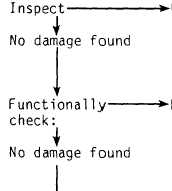|
| |
TM 9-2320-356-BD
CHAPTER 13
FRAME AND SUSPENSION
BDAR FIXES SHALL BE USED ONLY IN COMBAT
AT THE DISCRETION OF THE COMMANDER
AND SHALL BE REPAIRED BY STANDARD MAINTENANCE PROCEDURES
AS SOON AS PRACTICABLE AFTER THE MISSION IS COMPLETED.
Section 1. GENERAL
13-1.
GENERAL
The frame consists of those parts which support the vehicle and tie the various
units together.
The frame consists of left and right side members which are
pressed steel channel sections.
The crossmembers, gussets, brackets,
reinforcements,
and rear engine mounts are riveted to these sections.
The rear
suspension assembly of a tandem setup uses six torque rod assemblies, two upper and
four lower.
The load is equalized between axles by full-floating springs oscillate
on a cross shaft.
Axles are kept in place by spring guide brackets on axle
housings.
Driving and braking forces are transmitted to the frame by the six
torque rod assemblies which also maintain correct vertical position of axles and
prevent weight transfer between axles.
The front suspension system is more complex than the rear suspension system. The
front suspension system must allow the wheels to move up and down and must also
allow the wheels to pivot from side to side so that the vehicle can be steered.
In smaller vehicles, the front suspension is basically the same as in larger ones.
The rear suspension differs because the smaller vehicle has only one axle, while
the larger vehicles have two or more.
There are three basic types of springs: leaf, coil, and torsion bar. Most small
vehicles use coil or torsion bar springs at the front wheels.
Some vehicles use
coil springs at the rear wheels, but most use leaf springs.
Spring damage is the
single most frequent cause of suspension failure.
13-2. ASSESSMENT CHART
a.
Damage found to:
-Torque rod;. . . . . . . . . go to paragraph 13-5
-Coil springs; . . . . . . . go to paragraph 13-6
-Leaf springs; . . . . . . . go to paragraph 13-7
b.
Damage found to:
-Torque rod;. . . . . . . . . . go to paragraph 13-5
13-1
|

